France
From jeena
This article is about the country. For other uses, see France (disambiguation).
| French Republic
République française
|
||||||
|---|---|---|---|---|---|---|
|
||||||
| Motto: Liberté, égalité, fraternité (Liberty, Equality, Fraternity) |
||||||
| Anthem: "La Marseillaise" |
||||||
![Location of Metropolitan France (dark green)– in Europe (green & dark grey)– in the European Union (green) — [Legend]](http://upload.wikimedia.org/wikipedia/commons/thumb/a/a3/EU-France.svg/250px-EU-France.svg.png)
Location of Metropolitan France (dark green)
|
||||||
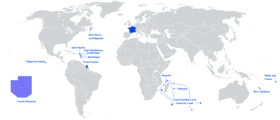
Territory of the French Republic in the world1
|
||||||
| Capital (and largest city) |
Paris 48°51.4′N 2°21.05′E |
|||||
| Official language(s) | French[a] | |||||
| Demonym | French | |||||
| Government | Unitary semi-presidential constitutional republic | |||||
| - | President | François Hollande | ||||
| - | Prime Minister | Jean-Marc Ayrault | ||||
| Legislature | Parliament | |||||
| - | Upper house | Senate | ||||
| - | Lower house | National Assembly | ||||
| Formation | ||||||
| - | Francia | 486 (Unification by Clovis) | ||||
| - | West Francia | 843 (Treaty of Verdun) | ||||
| - | French First Republic | 1792 (National Convention) | ||||
| - | Current constitution | 4 October 1958 (5th Republic) | ||||
| Area | ||||||
| - | Total[b] | 674,843 km2 (41st) 260,558 sq mi |
||||
| - | Metropolitan France | |||||
| - IGN[c] | 551,695 km2 (47th) 213,010 sq mi |
|||||
| - Cadastre[d] | 543,965 km2 (47th) 210,026 sq mi |
|||||
| Population | ||||||
| (2012 estimate) | ||||||
| - | Total[b] | 65,350,000[2] (20th) | ||||
| - | Metropolitan France | 63,460,000[1] (22nd) | ||||
| - | Density[e] | 116/km2 (89th) 301/sq mi |
||||
| GDP (PPP) | 2012 estimate | |||||
| - | Total | $2.257 trillion[3] (9th) | ||||
| - | Per capita | $35,613[3] (24th) | ||||
| GDP (nominal) | 2012 estimate | |||||
| - | Total | $2.712 trillion[3] (5th) | ||||
| - | Per capita | $42,793[3] (20th) | ||||
| Gini (2008) | 28.9[4] | |||||
| HDI (2011) | ||||||
| Currency | Euro,[f] CFP franc[g] ( EUR, XPF) |
|||||
| Time zone | CET[h] (UTC+1) | |||||
| - | Summer (DST) | CEST[i] (UTC+2) | ||||
| Drives on the | right | |||||
| ISO 3166 code | FR | |||||
| Internet TLD | .fr[j] | |||||
| Calling code | 33[k] | |||||
| 1 | Excluding Adélie Land in Antarctica, where sovereignty is suspended. | |||||
Over the past 500 years, France has been a major power with strong cultural, economic, military and political influence in Europe and around the world.[6] During the 17th and 18th centuries, France colonised great parts of North America and Southeast Asia; during the 19th and early 20th centuries, France built the second largest colonial empire of the time, including large portions of North, West and Central Africa, Southeast Asia, and many Caribbean and Pacific Islands.
France has its main ideals expressed in the Declaration of the Rights of Man and of the Citizen. The French Republic is defined as indivisible, secular, democratic and social by its constitution.[7] France is one of the world's most developed countries,[8] it possesses the world's fifth largest economy measured by GDP, the ninth-largest economy measured by purchasing power parity and is Europe's second largest economy by nominal GDP.[9] France is the wealthiest nation in Europe – and the fourth wealthiest in the world – in aggregate household wealth.[10] France enjoys a high standard of living as well as a high public education level, and has also one of the world's longest life expectancies.[11] France has been listed as the world's "best overall health care" provider by the World Health Organization.[12] It is the most visited country in the world, receiving 82 million foreign tourists annually.[13]
France has the world's fifth largest nominal military budget,[14] as well as (in terms of personnel) the largest military in the EU, the third largest in NATO and one of the largest in the world.[verification needed] France also possesses the third largest stockpile of nuclear weapons in the world[15] – with around 300 active warheads as of 25 May 2010 – and the world's second largest diplomatic corps (second only to that of the United States).[16] France is a founding member of the United Nations, one of the five permanent members of the UN Security Council, and a member of the Francophonie, the G8, G20, NATO, OECD, WTO, and the Latin Union. It is also a founding and leading member state of the European Union and the largest EU state by area.[17] In 2011, France was listed 20th on the Human Development Index and 24th on the Corruption Perceptions Index (2010).
Contents
|
Etymology
Main article: Name of France
The name "France" comes from the Latin Francia, which means "country of the Franks".[18] There are various theories as to the origin of the name of the Franks. One is that it is derived from the Proto-Germanic word frankon which translates as javelin or lance as the throwing axe of the Franks was known as a francisca.[19] Another proposed etymology is that in an ancient Germanic language, Frank means free as opposed to slave.History
Main article: History of France
Prehistory and antiquity
Main articles: Prehistory of France, Gaul, and Roman Gaul

At the end of the Last glacial period (10,000 BC), the climate softened[20] and from approximately 7,000 BC, this part of Western Europe entered the Neolithic era and its inhabitants became sedentary. After a strong demographic and agricultural development between the 4th and 3rd millennia, metallurgy appeared at the end of the 3rd millennium, initially with the work of gold, copper and bronze, and later with iron.[21] France counts numerous megalithic sites from the Neolithic period, including the exceptionally dense Carnac stones site (Morbihan, approximately 3,300 BC).
In 600 BC, Ionian Greeks, originating from Phocaea, founded the colony of Massalia (present-day Marseille), on the shores of the Mediterranean Sea, making it the oldest city of France.[22][23] At the same time, some Gallic Celtic tribes penetrated some parts of the current territory of France, but this occupation spread in the rest of France only between the 5th and 3rd century BC.[24]


The Gallic invasion left Rome weakened and encouraged several subdued Italian tribes to rebel. One by one, over the course of the next 50 years, these tribes were defeated and brought back under Roman dominion. The Gauls continued to harass the region until 345 BC, when they entered into a formal peace treaty with Rome. But the Romans and the Gauls would maintain an adversarial relationship for the next several centuries and the Gauls would remain a threat in Italia.
Around 125 BC, the south of Gaul was conquered by the Romans, who called this region Provincia Romana ("Roman Province"), which over time evolved into the name Provence in French.[25] Brennus' siege of Rome was still remembered by Romans, when Julius Caesar conquered the remainder of Gaul and overcame a revolt carried out by the Gallic chieftain Vercingetorix in 52 BC.[26]
Gaul was divided by Augustus into Roman provinces, the principal ones being Gallia Narbonensis in the south, Gallia Aquitania in the south-west, Gallia Lugdunensis in the center and Gallia Belgica in the north.[27] Many cities were founded during the Gallo-Roman period, including Lugdunum (present-day Lyon), which is considered to be the capital of the Gauls.[27] These cities were built in the traditional Roman style, with a forum, a theatre, a circus, an amphitheatre and thermal baths. The Gauls mixed with Roman settlers and eventually adopted Roman speech (Latin, from which the French language evolved) and Roman culture. The Roman polytheism merged with the Gallic paganism into the same syncretism.
Around the 3rd century AD, Roman Gaul underwent a serious crisis with its "limes" (fortified borders protecting the Empire) crossed on several occasions by Barbarians.[28] The weakness of the central imperial power, at this time, led Gallo-Roman leaders to proclaim the independence of the short-lived Gallic Empire,[28] which ended with the Battle of Châlons in 274, which saw Gaul reincorporated in the Roman Empire.
Nevertheless, the situation improved in the first half of the 4th century, which was a period of revival and prosperity for Roman Gaul.[29] In 312, the emperor Constantin I converted to Christianity. Christians, persecuted until then, multiplied across the entire Roman Empire.[30] But, from the second half of the 4th century, the Barbarian Invasions started again,[31] and Germanic tribes, such as the Vandals, Suebi and Alans crossed the Rhine and settled in Gaul, Spain and other parts of the collapsing Roman Empire.[32]
At the end of the Antiquity period, ancient Gaul was divided into several Germanic kingdoms (Early Francia (North), Alamannia (North-East), Burgundia (East), Septimania (South), Visigothic Aquitania (South East)) and a remaining Gallo-Roman territory, known as the Kingdom of Syagrius (West). Simultaneously, Celtic Britons, fleeing the Anglo-Saxon invasion of Britannia, settled the western part of Armorica (far West of Gaul). As a result, the Armorican peninsula was renamed Brittany, Celtic culture was revived and independent petty kingdoms arose in this region.
Middle Ages to revolution
Main articles: Francia, France in the Middle Ages, Absolute monarchy in France, Ancien Régime, Early modern France, and List of French monarchs
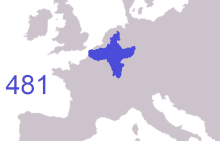

Proclaimed Holy Roman Emperor by Pope Leo III and thus establishing in earnest the French government's longtime historical association with the Roman Catholic Church,[34] Charlemagne tried to revive the Western Roman Empire and its cultural grandeur, from his Palace of Aachen. The efficient administration of this immense empire was ensured by high-level civil servants, carrying the, then non-hereditary, titles of counts (in charge of a County), marquis (in charge of a March), dukes (military commanders), etc.

During the course of the 9th and 10th centuries, continually threatened by Viking invasions, France became a very decentralised state: the nobility's titles and lands became hereditary, and the authority of the king became more religious than secular and thus was less effective and constantly challenged by powerful noblemen. Thus was established feudalism in France. Over time, some of the king's vassals would grow so powerful that they often posed a threat to the king. For example, after the Battle of Hastings in 1066, the Duke of Normandy added "King of England" to his titles, becoming both the vassal to (as Duke of Normandy) and the equal of (as king of England) to the king of France.
The Carolingian dynasty ruled France until 987, when Hugh Capet, Duke of France and Count of Paris, was crowned King of France.[36] His descendants, the Direct Capetians, the House of Valois and the House of Bourbon, progressively unified the country through a series of wars, such as the Saintonge War, and dynastic inheritance into the Kingdom of France. French knights took an active part in many of the Crusades that were fought between 1095 and 1291 to restore Christian control over the Holy Land. Crusaders were so predominately French that the word "crusader" in the Arabic language is simply known as Al-Franj or "The Franks"[37] and Old French became the lingua franca of the Kingdom of Jerusalem.[38]

Charles IV (The Fair) died without an heir in 1328.[40] Under the rules of the Salic law adopted in 1316, the crown of France could not pass to a woman nor could the line of kinship pass through the female line.[40] Accordingly, the crown passed to Philip of Valois, a cousin of Charles, rather than through the female line to Charles' nephew, Edward, who would soon become Edward III of England. During the reign of Philip of Valois, the French monarchy reached the height of its medieval power.[40]
However, Philip's seat on the throne was contested by Edward III of England and in 1337, on the eve of the first wave of the Black Death,[41] England and France went to war in what would become known as the Hundred Years' War.[42] The exact boundaries changed greatly with time, but French landholdings of the English Kings remained extensive for decades.
With charismatic leaders, such as Joan of Arc and La Hire, strong French counterattacks won back all English continental territories, except Calais, which was captured in 1558 by the French. Like the rest of Europe, France was struck by the Black Death. Around 1340, France had a population of approximately 17 million,[43] which by the end of the pandemic had declined by about one-half.[44]

The rise of Protestantism in Europe led France to a civil war known as the French Wars of Religion, where, in the most notorious incident, thousands of Huguenots were murdered in the St. Bartholomew's Day massacre of 1572.[45] The Wars of Religion were ended by Henry IV's Edict of Nantes, which granted some freedom of religion to the Huguenots. Henry IV was later murdered by a Catholic fanatic and Huguenot rebellions persisted until the 18th century.
Under Louis XIII, the energetic actions of Cardinal Richelieu reinforced the centralization of the state, the royal power and French dominance in Europe, foreshadowing the reign of Louis XIV. During Louis XIV's minority and the regency of Queen Anne and Cardinal Mazarin, a period of trouble known as the Fronde occurred in France, which was at that time at war with Spain. This rebellion was driven by the great feudal lords and sovereign courts as a reaction to the rise of royal power in France.

Under Louis XV, France lost New France and most of its Indian possessions after its defeat in the Seven Years' War, which ended in 1763. Its continental territory kept growing, however, with notable acquisitions such as Lorraine (1766) and Corsica (1770). An unpopular king, Louis XV's weak rule, his ill-advised financial, political and military decisions, and his debauchery discredited the monarchy and arguably led to the French Revolution 15 years after his death.[47][48]
Louis XVI, Louis XV's grandson, actively supported the Americans, who were seeking their independence from Great Britain (realized in the 1783 Treaty of Paris). The example of the American Revolution and the financial crisis which followed France's involvement in the war were two of the many contributing factors to the French Revolution.
Much of the Enlightenment occurred in French intellectual circles, and major scientific breakthroughs and inventions, such as the discovery of oxygen (1778) and the first hot air balloon carrying passengers (1783), were achieved by French scientists in the 18th century. Famous French explorers, such as Bougainville and Lapérouse, took part in the voyages of scientific exploration through maritime expeditions around the globe. The Enlightenment philosophy, in which reason is advocated as the primary source for legitimacy and authority, undermined the power of and support for the monarchy and helped pave the way for the French Revolution.
Monarchy to republic
Main articles: France in the long nineteenth century and France in the 20th century
See also: French Revolution, Napoleonic era, and French colonial empire
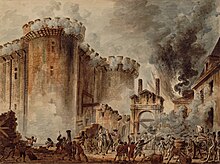

As European monarchies gathered against the new régime, to restore the French absolute monarchy, the Duke of Brunswick, commanding general of the Austro–Prussian Army, issued a Manifesto, in which he threatened the destruction of Paris if any harm should come to the king or his family. The foreign threat exacerbated France's political turmoil and deepened the passion and sense of urgency among the various factions and war was declared against Austria the 20 April 1792. Mob violences occurred during the insurrection of the 10 August 1792[49] and the following month.[50] As a result of the spike in public violence and the political instability of the constitutional monarchy, the Republic was proclaimed on 22 September 1792.
Louis XVI (and later his wife Marie Antoinette) was convicted of treason and guillotined in 1793. Facing increasing pressures from European monarchies, internal guerrilla wars and counterrevolutions (like the War in the Vendée or the Chouannerie), the young Republic fell into the Reign of Terror. Between 1793 and 1794, 16,000 to 40,000 persons were executed. In Western France, the civil war between the Bleus (the "Blues", supporters of the Revolution) and the Blancs (the "Whites", supporters of the Monarchy) last from 1793 to 1796 and cost around 450,000 lives (200,000 Patriotes and 250,000 Vendéens).[51] Both foreign armies and French counterrevolutionnaries were crushed and the French Republic survived. Furthermore, the French Republic extended greatly its boundaries and established "Sister Republics" in the surrounding countries. As the threat of a foreign invasion receded and that France became mostly pacified, the Thermidorian Reaction put an end to the Terror and to Robespierre's dictature. The abolition of slavery and the male universal suffrage, enacted during this radical phase of the revolution, were cancelled by subsequent governments.


France had colonial possessions, in various forms, since the beginning of the 17th century to the 18th century. But in the 19th and 20th centuries, its global overseas colonial empire extended greatly and culminated as the second largest in the world behind the British Empire. At its peak, between 1919 and 1939, the second French colonial empire extended over 12,347,000 square kilometres (4,767,000 sq mi) of land. Including metropolitan France, the total area of land under French sovereignty reached 12,898,000 square kilometres (4,980,000 sq mi) in the 1920s and 1930s, which is 8.6% of the world's land area.

The Fourth Republic was established after World War II and saw spectacular economic growth (les Trente Glorieuses). Suffrage was extended to women in 1944. France was one of the founding members of the NATO (1949), which was the Western counterpart of the Warsaw Pact system of collective defence. France attempted to regain control of French Indochina but was defeated by the Viet Minh at the Battle of Dien Bien Phu in 1954. Only months later, France faced a new conflict in Algeria. The debate over whether or not to keep control of Algeria, then home to over one million European settlers,[55] wracked the country and nearly led to civil war. In 1958, the weak and unstable Fourth Republic gave way to the Fifth Republic, which contained a strengthened Presidency.[56] In the latter role, Charles de Gaulle managed to keep the country together while taking steps to end the war. The Algerian War was concluded with peace negotiations in 1962 that led to Algerian independence. France granted independence progressively to its colonies, the last one being Vanuatu in 1980. A vestige of the colonial empire are the French overseas departments and territories.
In the wake of a worldwide series of protests, the May 1968 revolt, although a political failure for the protesters, had an enormous social impact. In France, it is considered to be the watershed moment when a conservative moral ideal (religion, patriotism, respect for authority) shifted towards a more liberal moral ideal.
France has been at the forefront of the European Union member states seeking to exploit the momentum of monetary union to create a more unified and capable European Union political, defence, and security apparatus.[57]
Geography
Main article: Geography of France

While Metropolitan France is located in Western Europe, the French Republic also has a number of territories in North America, the Caribbean, South America, the southern Indian Ocean, the Pacific Ocean, and Antarctica.[58] These territories have varying forms of government ranging from overseas department to overseas collectivity. France's overseas departments and collectivities share land borders with Brazil, and Suriname (bordering French Guiana), and Sint Maarten (bordering Saint-Martin).
The European territory of France covers 547,030 square kilometres (211,209 sq mi),[59] having the largest area among European Union members.[17] France possesses a wide variety of landscapes, from coastal plains in the north and west to mountain ranges of the Alps in the south-east, the Massif Central in the south-central and Pyrenees in the south-west.
At 4,810.45 metres (15,782 ft)[60] above sea level, the highest point in Western Europe, Mont Blanc, is situated in the Alps on the border between France and Italy. France also has extensive river systems such as the Seine, the Loire, the Garonne, and the Rhone, which divides the Massif Central from the Alps and flows into the Mediterranean Sea at the Camargue. Corsica lies off the Mediterranean coast.

In the south-east a Mediterranean climate prevails. In the west, the climate is predominantly oceanic with a high level of rainfall, mild winters and cool to warm summers. Inland the climate becomes more continental with hot, stormy summers, colder winters and less rain. The climate of the Alps and other mountainous regions is mainly alpine, with the number of days with temperatures below freezing over 150 per year and snow cover lasting for up to six months.
| Landscapes and climates of France | ||||||||||||||||||||
|
||||||||||||||||||||
Environment
See also: Ministry of Ecology, Sustainable Development, Transport and Housing, National parks of France, and Regional natural parks of France

Like all European Union members, France agreed to cut carbon emissions by at least 20% of 1990 levels by the year 2020,[69] in comparison the USA agreed to a cut of 4% of its emissions[70] whereas China stated it wanted to "reduce its carbon intensity by 40–45% by the year 2020" (compared with 2005 levels),[71] which means with a GDP growth of 8% yearly an augmentation of 80%[70] to 250%[72] of the Chinese carbon emissions by 2020.
In 2009, the French carbon dioxide emissions per capita level is lower than the Chinese one.[73]
France was even set to impose a carbon tax in 2009 at 17 Euros per tonne of carbon dioxide emitted.[74] The carbon tax would have brought in 4.3 billion Euros of revenue per year.[75] However, 6 months later, the plan for a carbon tax was abandoned for various reasons, one being that French companies would have a more difficult time competing with companies in neighboring countries who would not have to pay such steep taxes on carbon dioxide emissions. Instituting a carbon tax was also an unpopular political move for President Sarkozy.[76]
In 2010, a study at Yale and Columbia universities ranked France the 7th most environmentally conscious country in the world.[77][78]
Forests account for 28% of the land area of France.[79][80] France is the second most wooded country of the EU.[81] French forests are also some of the most diversified of Europe, with more than 140 differents varieties of trees.[82] There are 9 national parks[83] and 46 natural parks in France.[84] France wants to convert 20% of its Exclusive Economic Zone in a Marine Protected Area by 2020.[85]








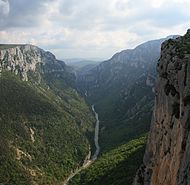
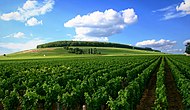

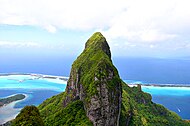


No comments:
Post a Comment